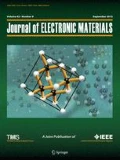Abstract
We analysed the steady state performance of a segmented annular thermoelectric generator (SATEG). The thermoelectric leg consists of high-, medium- and low-temperature thermoelectric materials joined in series and its cross-sectional area is asumed to be constant. The simplified solution of current in an SATEG and the optimized external resistance corresponding to maximum output power and maximum conversion efficiency are performed. This is more convenient for engineering application than the exact solution. Numerical results calculated based on the simplified solutions agree well with the exact solutions. It is found that the output power and conversion efficiency of an SATEG are not bounded by its segments and can be higher than those of each segment through the proper selection of material combination and segment’s length. A design guideline for segmented thermoelectric generators (STEGs) based on figure of merit of high-, medium- and low-temperature thermoelectric segments is proposed. This study will be helpful for the optimization design of STEG devices.
Similar content being viewed by others
Abbreviations
- A 0 :
-
Cross-section area of thermoelectric leg, m2
- H :
-
Height of thermoelectric segment, m
- I :
-
Electrical current, A
- K :
-
Overall thermal conductance, W/(mK)
- P :
-
Output power, W
- Q :
-
Rate of heat flow, W
- r :
-
Radial direction, m
- R :
-
Overall electrical resistance, Ω
- T :
-
Temperature, K
- V :
-
Voltage, V
- ZT :
-
Figure of merit
- R L :
-
External resistance, Ω
- T m :
-
Temperature at the junction of the first and second segment, K
- T l :
-
Temperature at the junction of the second and third segment, K
- P* :
-
Power density, W/(cm2)
- \( \alpha \) :
-
Seebeck coefficient, V/K
- \( k \) :
-
Thermal conductivity, W/m
- \( \sigma \) :
-
Electrical conductivity, S/m
- θ :
-
Angle, rad
- η :
-
Efficiency
- δ :
-
Thickness of thermoelectric legs, m
- n :
-
n-Type leg
- p :
-
p-Type leg
- h:
-
Heat source
- c:
-
Heat sink
- eff:
-
Effective property
- i:
-
Thermocouple segment number
- 1:
-
First thermocouple segment
- 2:
-
Second thermocouple segment
- 3:
-
Third thermocouple segment
References
D.M. Rowe, CRC Handbook of Thermoelectrics (Boca Raton: CRC Press, 1995).
L.E. Bell, Science 321, 1457 (2008).
G.J. Snyder and E.S. Toberer, Nature 7, 105 (2008).
D. Narducci, Appl. Phys. Lett. 99, 102104 (2011).
H. Wang, A. Jasim, and X.D. Chen, Appl. Energy 212, 1083 (2018).
R. Quan, X. Tang, S. Quan, and L. Huang, J. Electron. Mater. 42, 1469 (2013).
D.M. Rowe, Thermoelectrics Handbook Macro to Nano (Boca Raton: CRC Press, 2006).
H. Lee, Appl. Energy 106, 79 (2013).
G.J. Snyder and T.S. Ursell, Phys. Rev. Lett. 91, 148301 (2003).
L.D. Zhao, G.J. Tan, S.Q. Hao, J.Q. He, Y.L. Pei, H. Chi, H. Wang, S.K. Gong, H.B. Xu, V.P. Dravid, C. Uher, G.J. Snyder, C. Wolverton, and M.G. Kanatzidis, Science 351, 141 (2016).
J. He and T.M. Tritt, Science 357, eaak9997 (2017).
J. Kim, Y.T. Kang, S.N. Kang, J.H. Hwang, S.G. Lee, H. Hong, and M.G. Kim, Int. J. Therm. Sci. 47, 486 (2008).
G.J. Snyder, Appl. Phys. Lett. 84, 2436 (2004).
G.B. Zhang, L.H. Fan, Z.Q. Niu, K. Jiao, H. Diao, Q. Du, and G.Q. Shu, Energy Convers. Manag. 106, 510 (2015).
H.S. Kim, K. Kikuchi, T. Itoh, T. Iida, and M. Taya, Mater. Sci. Eng. B 185, 45 (2014).
H. Ali, B.S. Yilbas, and A. Al-Sharafi, Int. J. Energy Res. 42, 477 (2018).
G. Min and D.M. Rowe, Sci. Technol. 22, 880 (2007).
Z.G. Shen, S.Y. Wu, and L. Xiao, Energy Convers. Manag. 89, 244 (2015).
A.B. Zhang, B.L. Wang, D.D. Pang, L.W. He, J. Lou, J. Wang, and J.K. Du, Energy 147, 612 (2018).
S.C. Kaushik and S. Manikandan, Energy Convers. Manag. 103, 200 (2015).
A. Bauknecht, T. Steinert, C. Spengler, and G. Suck, J. Electron. Mater. 42, 1641 (2013).
A.B. Zhang, B.L. Wang, D.D. Pang, J.B. Chen, J. Wang, and J.K. Du, Energy Convers. Manag. 166, 337 (2018).
Z.G. Shen, X. Liu, S. Chen, S.Y. Wu, L. Xiao, and Z.X. Chen, Energy 157, 297 (2018).
S.F. Fan and Y.W. Gao, Energy 183, 35 (2019).
S. Shittu, G.Q. Li, X.D. Zhao, X.L. Ma, Y.G. Akhlaghi, and E. Ayodele, Energy Convers. Manag. 184, 180 (2019).
E.J. Sandoz-Rosado, S.J. Weinstein, and R.J. Stevens, Int. J. Therm. Sci. 66, 1 (2013).
P.F. Qiu, R.H. Liu, J. Yang, X. Shi, X.Y. Huang, W. Zhang, L.D. Chen, J.H. Yang, and D.J. Singh, J. Appl. Phys. 111, 23705 (2012).
J. Davidow and Y. Gelbstein, J. Electron. Mater. 42, 1542 (2013).
F. Wu, W. Wang, X. Hu, and M. Tang, Prog. Nat. Sci. Mater. Int. 27, 203 (2017).
A. Narjis, C.T. Liang, H. El Aakib, A. Tchenka, and A. Outzourhit, J. Electron. Mater. 49, 306 (2020).
Y.R. Koh, K. Yazawa, A. Shakouri, T. Nagahama, S. Maeda, T. Isaji, and Y. Kasai, J. Electron. Mater. 48, 7312 (2019).
Acknowledgments
We thank the two anonymous reviewers for their comments on the original manuscript, which are especially useful for improving the presentation and quality of the final paper. The research was supported by the Ningbo Natural Science Foundation (2019A610151), the Natural Science Foundation of Zhejiang Province of China (LY17A020001), the National Natural Science Foundation of China (NSFC) (Project No. 11402063), and the K. C. Wong Magna Fund in Ningbo University.
Author information
Authors and Affiliations
Corresponding author
Additional information
Publisher's Note
Springer Nature remains neutral with regard to jurisdictional claims in published maps and institutional affiliations.
Rights and permissions
About this article
Cite this article
Wen, Z.F., Sun, Y., Zhang, A.B. et al. Performance Analysis of a Segmented Annular Thermoelectric Generator. J. Electron. Mater. 49, 4830–4842 (2020). https://doi.org/10.1007/s11664-020-08208-5
Received:
Accepted:
Published:
Issue Date:
DOI: https://doi.org/10.1007/s11664-020-08208-5



